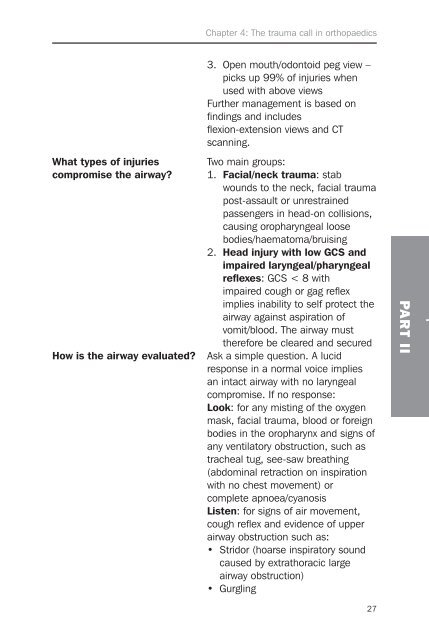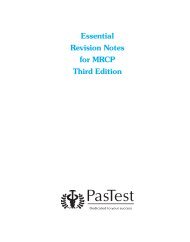Fast Track Surgery: Trauma, Orthopaedics and the ... - PasTest
Fast Track Surgery: Trauma, Orthopaedics and the ... - PasTest
Fast Track Surgery: Trauma, Orthopaedics and the ... - PasTest
- No tags were found...
You also want an ePaper? Increase the reach of your titles
YUMPU automatically turns print PDFs into web optimized ePapers that Google loves.
Chapter 4: The trauma call in orthopaedicsWhat types of injuriescompromise <strong>the</strong> airway?How is <strong>the</strong> airway evaluated?3. Open mouth/odontoid peg view –picks up 99% of injuries whenused with above viewsFur<strong>the</strong>r management is based onfindings <strong>and</strong> includesflexion-extension views <strong>and</strong> CTscanning.Two main groups:1. Facial/neck trauma: stabwounds to <strong>the</strong> neck, facial traumapost-assault or unrestrainedpassengers in head-on collisions,causing oropharyngeal loosebodies/haematoma/bruising2. Head injury with low GCS <strong>and</strong>impaired laryngeal/pharyngealreflexes: GCS < 8 withimpaired cough or gag refleximplies inability to self protect <strong>the</strong>airway against aspiration ofvomit/blood. The airway must<strong>the</strong>refore be cleared <strong>and</strong> securedAsk a simple question. A lucidresponse in a normal voice impliesan intact airway with no laryngealcompromise. If no response:Look: for any misting of <strong>the</strong> oxygenmask, facial trauma, blood or foreignbodies in <strong>the</strong> oropharynx <strong>and</strong> signs ofany ventilatory obstruction, such astracheal tug, see-saw breathing(abdominal retraction on inspirationwith no chest movement) orcomplete apnoea/cyanosisListen: for signs of air movement,cough reflex <strong>and</strong> evidence of upperairway obstruction such as:• Stridor (hoarse inspiratory soundcaused by extrathoracic largeairway obstruction)• Gurgling27PART II
















